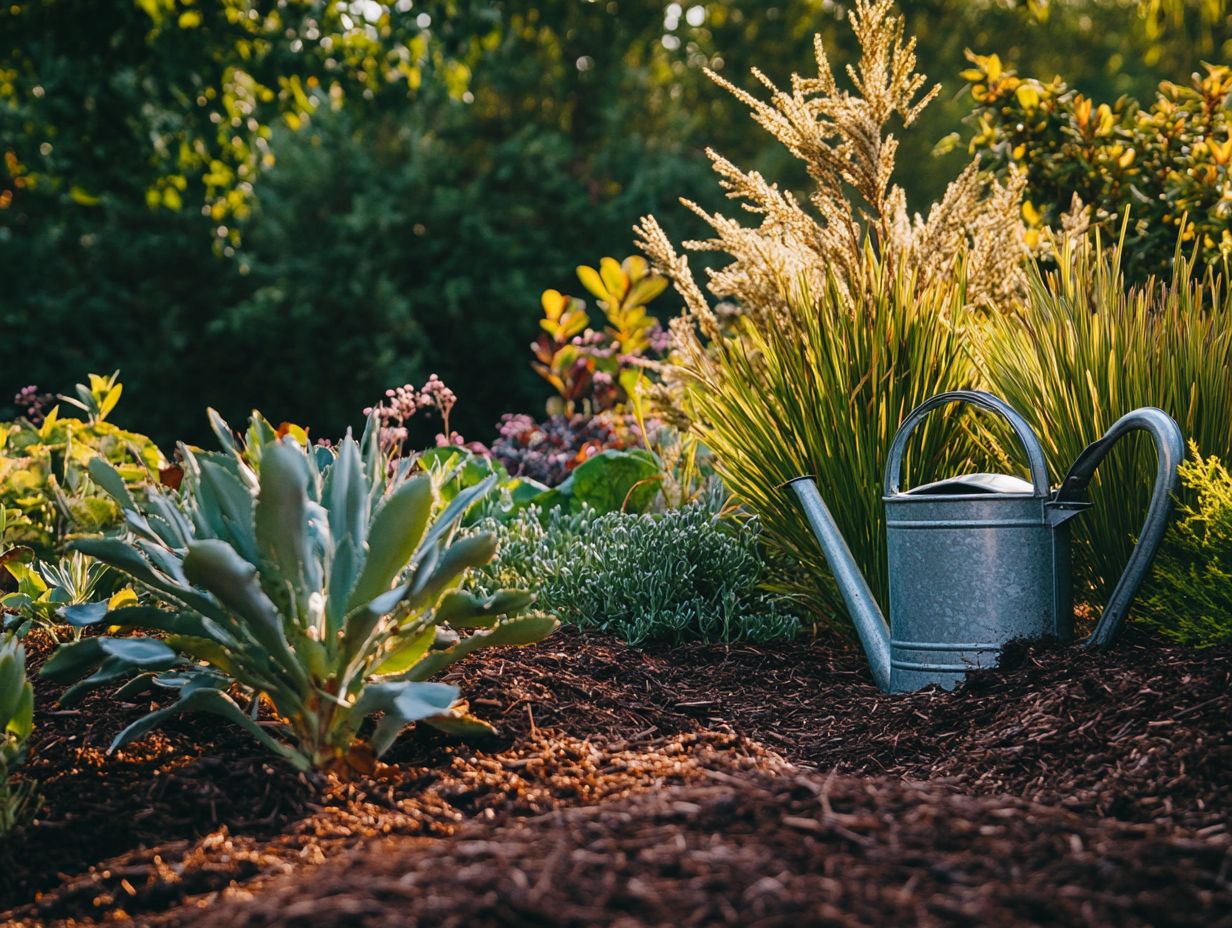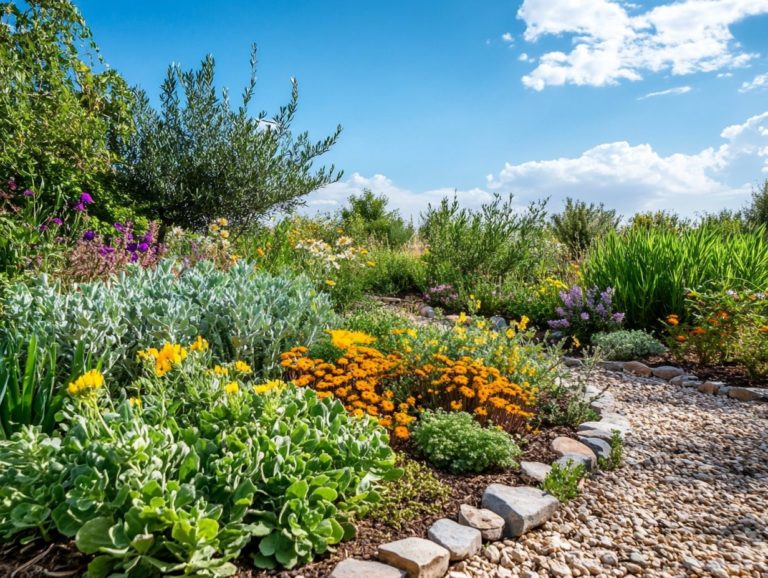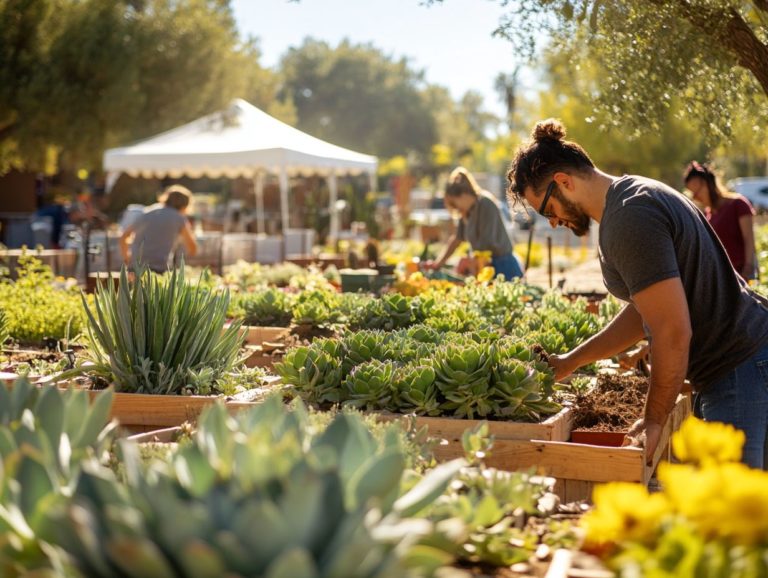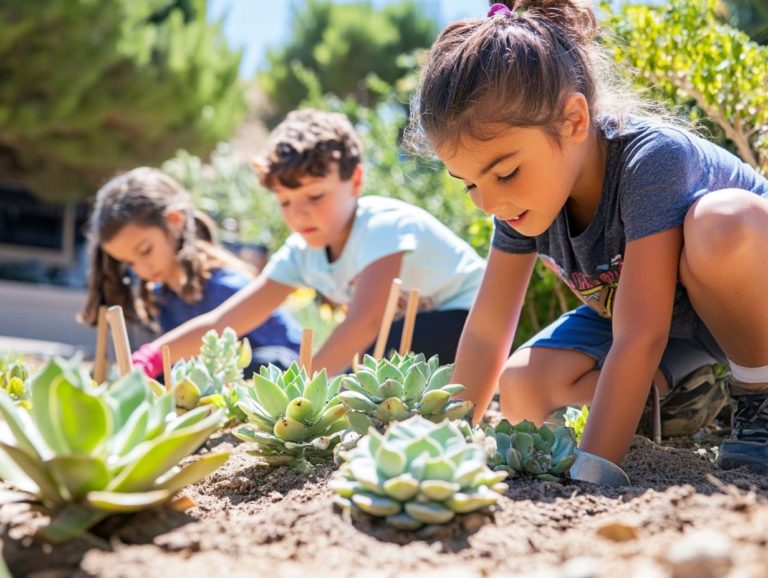The Benefits of Mulching in Drought Gardening
Drought gardening is becoming a vital practice as climate challenges reshape our landscapes. By grasping the principles of cultivating resilience in your garden, you can significantly enhance plant health during unforgiving dry spells.
Let s dive into how mulching can transform your drought garden! This article highlights its myriad benefits, various types, and best practices for effective application.
Discover strategies for maximizing water conservation and enriching soil health. Arm yourself with the knowledge necessary to flourish, even in drought conditions.
Contents
- Key Takeaways:
- Understanding Drought Gardening
- The Importance of Mulching in Drought Gardening
- Types of Mulch for Drought Gardening
- How to Properly Mulch in Drought Gardening
- Additional Benefits of Mulching
- Tips for Success in Drought Gardening
- Frequently Asked Questions
- What is mulching?
- What types of materials can be used for mulching in drought gardening?
- What are the environmental benefits of mulching in drought gardening?
- How often should I mulch in my drought garden?
- Can mulching help save money in drought gardening?
- Tips for Successful Mulching in Drought Gardening
Key Takeaways:

- Mulching helps retain moisture in the soil and reduces the need for frequent watering.
- Consider using organic materials like bark or leaves for mulch, as they offer weed control and improve soil health.
- Besides conserving water, mulching regulates soil temperature, prevents erosion, and enhances your garden’s appearance.
Understanding Drought Gardening
Drought gardening offers a refined strategy for cultivating plants in environments where water is scarce. This is a crucial skill for farmers striving to sustain crop yields amid unpredictable weather.
Familiarizing yourself with drought-resistant plants and implementing effective soil management techniques allows you to cultivate a resilient ecosystem. This ecosystem conserves moisture and supports robust plant growth, even in severe drought conditions.
What is Drought Gardening?
Drought gardening involves practices designed to cultivate plants where water is limited while promoting sustainable farming methods. This approach emphasizes choosing drought-resistant plant varieties adapted to thrive with minimal water.
It encourages implementing soil management strategies that enhance moisture retention, such as incorporating organic matter and mulching. Techniques like drip irrigation a method that delivers water directly to the plant roots and rainwater harvesting help minimize water waste and ensure that your plants receive essential hydration.
The advantages of drought gardening extend beyond water conservation. They also foster healthier ecosystems, reduce reliance on municipal water supplies, and promote biodiversity by encouraging the growth of native plants suited to survive in arid conditions.
The Importance of Mulching in Drought Gardening
Mulching is essential in drought gardening. It significantly aids in water retention within the soil, curbing evaporation and supplying vital nutrients to your plants. Understanding the role of mulch in drought gardening enhances soil health and fertility, preserving optimal moisture levels during extended dry spells.
Embracing mulching is more than just aesthetic; it s a crucial step for gardeners and farmers striving to thrive in challenging conditions.
How Mulching Helps in Drought Conditions
Mulching is vital during drought, as it curtails soil evaporation, preserves soil moisture, and bolsters the health of cover crops. Additionally, incorporating features like rain gardens in drought areas can enhance water retention. By applying a protective layer on the soil surface, you block direct sunlight and wind, which can hasten moisture loss.
Consider various mulch materials like straw, wood chips, and shredded leaves. Each offers distinct advantages in combating drought. For example, organic mulches like grass clippings retain moisture and decompose over time, enriching the soil with essential nutrients. Learning about the long-term benefits of drought gardening can further enhance your gardening efforts.
In arid climates, rock or gravel mulch can be particularly beneficial. These materials minimize evaporation and help maintain stable soil temperatures, creating an optimal environment for root development and improving infiltration.
Types of Mulch for Drought Gardening

In drought gardening, you’ll find two primary types of mulch: organic and inorganic. Each type has distinct advantages for keeping moisture in the soil and promoting soil health, along with several environmental benefits of drought gardening.
Organic mulches, like straw and crop residue, gradually decompose. They enrich the soil with essential nutrients.
In contrast, inorganic mulches offer enduring coverage and effective weed control. This ensures your garden remains resilient and thriving while minimizing erosion.
Organic vs. Inorganic
Organic mulch, such as straw and wood chips, serves as a powerful ally. It enriches your soil as it breaks down. On the other hand, inorganic mulch, like gravel or plastic, excels at long-term moisture retention and weed control.
Organic options nourish beneficial microorganisms. They also improve aeration, which is the process of allowing air to reach the soil, and enhance soil structure. This makes them vital for sustainable farming practices.
For example, straw mulch works wonders in vegetable gardens. It decomposes rapidly, infusing essential nutrients back into the soil.
On the flip side, inorganic mulches provide a low-maintenance solution. They effortlessly keep weeds at bay and minimize evaporation. However, they miss out on the soil-enhancing benefits of organic materials.
Evaluate the specific needs of your garden before selecting a mulch type. Often, a combination of both can lead to the best results.
How to Properly Mulch in Drought Gardening
To mulch effectively in drought gardening, follow these best practices. These practices enhance moisture retention, maintain optimal soil structure, and promote robust crop management, allowing you to enjoy the health benefits of gardening with drought plants.
Tailor your mulch application to suit the specific needs of your plants and the unique conditions of your garden or field. This is essential for achieving the best results.
Best Practices and Techniques
Using best practices for mulching can significantly boost your soil moisture retention. This is especially vital under drought conditions, highlighting the importance of mulching in water conservation, which is crucial for sustainable farming practices.
Applying a mix of organic and inorganic materials creates a protective barrier. This barrier conserves water, suppresses weeds, and regulates soil temperature.
Studies show that straw, wood chips, and shredded leaves boost soil quality as they break down. This fosters diverse microbial activity that is essential for nutrient availability.
It’s advisable to apply a layer of mulch about three to four inches thick. Make sure the base of your plants remains free from direct contact to prevent rot.
Timing is key! Apply mulch in early spring or late fall to maximize its benefits and bolster crop resilience during challenging weather patterns.
Additional Benefits of Mulching
Beyond merely managing water retention, mulching provides a wealth of advantages. It effectively controls weeds, enhances soil health, and promotes robust crop growth.
These benefits collectively foster a more sustainable approach to gardening. They elevate your gardening experience to new heights.
Weed Control and Soil Health

Mulching serves as a powerful ally in your quest to control weeds. Weeds can disrupt soil health by vying for precious nutrients and moisture.
Laying down a mulch barrier stops pesky weeds from growing and helps keep the soil moist. This means less frequent watering for you!
This water conservation creates optimal conditions for your plant roots to thrive. As the mulch gradually breaks down, it enriches the soil with organic matter, improving nutrient availability.
Healthier plants emerge from this enriched environment, making them more resilient against pests and diseases.
In the long run, your commitment to mulching fosters a vibrant ecosystem. This supports sustainable gardening practices and enhances the overall vitality of your soil.
Don t wait! Start mulching today to unlock the full potential of your garden!
Tips for Success in Drought Gardening
To succeed in drought gardening, it’s crucial for you to implement effective water conservation strategies and best practices. By doing so, you’ll maintain optimal soil moisture and support the overall health of your plants.
Other Strategies for Water Conservation
In addition to mulching, you can explore various other water conservation strategies, such as employing effective irrigation techniques and planting cover crops to enhance moisture retention.
For instance, consider using drip irrigation systems that deliver water directly to the roots of your plants. This method minimizes evaporation the process of water turning into vapor and runoff, conserving water while promoting healthy root development.
Opting for drought-tolerant cover crops like clover or vetch can significantly improve your soil structure. Not only do these plants reduce your water needs, but they also enhance soil fertility by helping add nutrients back into the soil.
By implementing sustainable practices like rainwater harvesting or incorporating organic matter you can further maintain adequate soil moisture levels. This will help you create a resilient, thriving garden, even in the face of dry conditions.
Frequently Asked Questions
What is mulching?
Mulching is the process of covering the soil with a layer of material, such as wood chips or straw. It helps retain moisture in the soil, which is crucial for drought gardening, by reducing evaporation and regulating soil temperature. For those interested in further advantages, understanding the economic benefits of drought-resistant gardening can promote better soil structure and enhance crop yield.
What types of materials can be used for mulching in drought gardening?

There are various materials that can be used for mulching in drought gardening, including straw, wood chips, shredded leaves, compost, natural mulch, and even newspaper. Additionally, using cover crops in drought gardening can further improve soil fertility. The key is to use organic materials that will decompose and add nutrients to the soil.
What are the environmental benefits of mulching in drought gardening?
Mulching helps reduce water consumption, soil erosion, and weed growth. It promotes healthy soil by increasing microbial activity and improving soil structure, which is vital for maintaining soil moisture and supporting healthy crops.
How often should I mulch in my drought garden?
You should mulch once or twice a year, depending on the material used and the severity of the drought, to ensure adequate water infiltration and retention, especially in sandy soil. In general, it is best to mulch in the spring and fall to prepare for the summer heat and winter cold.
Can mulching help save money in drought gardening?
Yes, mulching can help save money in drought gardening by reducing the need for watering and using synthetic fertilizers, while also conserving groundwater and minimizing soil erosion. It also minimizes the cost and effort of weed control, as well as the risk of plant diseases that thrive in dry conditions. For more insights, consider exploring the long-term benefits of drought gardening.
Tips for Successful Mulching in Drought Gardening
- Use a layer of at least 2-3 inches of mulch.
- Avoid piling mulch against plant stems.
- Leave a small space around the base of trees and shrubs to prevent rot.
- Regularly check the moisture level of the soil and adjust the amount of mulch accordingly based on weather conditions and the growth patterns of your plants.
Start your own drought gardening journey today! Implement these strategies and tips to create a flourishing garden that thrives even in challenging conditions.






